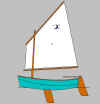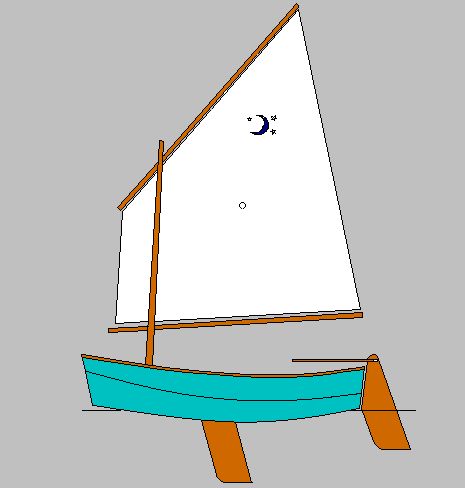John Bell
4460 Dunmovin Drive
Kennesaw, GA 30144
(770) 592-2165
jmbell@mindspring.com
Duckworks Design Contest 2001 Entry
Blondie came out my desire to build a boat for my 5 year old daughter Alison. Were you to see a picture of Alison, you’d also see where the name came from. At a recent messabout she was quite infatuated with another boat about this size. While the pram at the messabout certainly was a nice boat, I thought I’d like something a little different a little prettier. I drew Blondie to incorporate the features I wanted in a very small boat and to be an attractive addition to the waterfront scene. Blondie is intended as a sail trainer and yacht tender.
Blondie’s hull shape and hydrostatics were worked out with Gregg Carlson’s excellent Hull Designer freeware. The Hulls output was imported into TurboCad to produce these drawings. I have constructed a cardboard model that shows that the developed shape fits together without any problems.
Hull
 She is sized to hold an adult and a child comfortably and safely, and still offer enough sail carrying ability for a child to handle alone (with adult supervision). She has enough reserve buoyancy to sail two adults or row three. The interior of the hull reflects my preference for open, uncluttered spaces. Pram hulls are most popular for boats of this size, but I find them to be a bit homely. Blondie’s sharp-bowed shape is a lot prettier to my eye. She is sized to hold an adult and a child comfortably and safely, and still offer enough sail carrying ability for a child to handle alone (with adult supervision). She has enough reserve buoyancy to sail two adults or row three. The interior of the hull reflects my preference for open, uncluttered spaces. Pram hulls are most popular for boats of this size, but I find them to be a bit homely. Blondie’s sharp-bowed shape is a lot prettier to my eye.
I don’t like boats that drag one corner of their transom; it slows you down. The tucked up stern quarters prevent the dragging-corner problem and should help prevent the beamy hull from becoming hard-nosed when heeled. Getting a hull this size to plane isn’t easy, so I have not even tried. The fairly deep rocker instead gives good load carrying ability. This is a deep and beamy hull for it’s length of only 100” giving her power to stand up to her rig and depth enough to inspire confidence when heavily laden. She is designed for about up to 425 lbs maximum displacement, but is probably best sailed at no more than 330 lbs.
The daggerboard trunk is admittedly an experiment, supported only by its bedlogs and a plywood gusset filleted and taped to the bottom at the forward end. Even so, I think it is plenty strong enough for the job. South Georgia boat builder and raconteur Robb White builds the daggerboard trunks in his boats in much the same way, observing that the daggerboard is what usually breaks instead of the trunk even without robust reinforcement. If someone wanted to stretch a thwart across the top of the daggerboard trunk, I wouldn’t argue too much, but it is my observation that most small homebuilt boats are overbuilt at the expense of excessive weight. For use as a yacht tender, I’d suggest a moveable box about 14”x 12”x 6” high made out of scrap lumber instead of a fixed rowing thwart that would spoil the boat for sailing.
The plans show three temporary forms, but only the most obsessive builder deem to use that many. The only one that is really needed is the center one. The shape of the side panels is such that when they are stitched together that they only need to be held at the stem, the midsection and the transom to insure the proper shape. Never the less, the builder should measure across the top at the locations of the other forms once the hull is stitched to see if a temporary spreader is needed. The hull is stitch and glue construction with 6-9 oz. 3” tape on the insides and sheathed on the outside with 6 oz. cloth. The bilge panels do have a small amount of twist in them towards the stern. I would advise the builder to go slowly and deliberately when stitching the hull lest in his enthusiasm he rupture a strake in his rush to see the hull in three dimensions for the first time.

The Rig
I like balanced lugs. They are easy to handle due to their self-vanging nature and the fact that they don’t need a lot of rigging. Short spars for a given sail area are another virtue. With one of her intended uses as a tender, Blondie’s rig is designed so all the spars will fit completely inside the boat making for uncluttered stowage while being towed behind a larger boat. Her 40 sq. ft. sail area is maybe a little smaller than I’d want just for myself; but since I’m planning on turning my daughter and son loose with it, it’s big enough to offer them enough danger to make them good sailors and small enough that it won’t be too overwhelming in their first (supervised) solo forays. I’ve not made any attempt to use the second polytarp allowed in the contest rules on the boat it self, so I’ll suggest it be used as a cover for storage.
Materials
I’ve not endeavored to use all the lumber allotted in the contest rules. I drew the boat first, making small compromises only to get the panels nested on the plywood in a reasonable manner. But my vision of the boat came first. The other bits come out of the pile of parts with lots left over. Trying to use the rest of the material just makes the boat heavier with little added strength or functionality. I think of the extra material as a “get out of jail free” card for the inevitable beginning boat builder’s mistake of measuring twice and cutting it wrong anyway.
If the builder thought they’d be doing a lot of rowing, one good use of the extra wood would be a skeg about 24” long by 3” deep.
To build this boat, you will need the materials specified in the design contest rules plus the following.
- Epoxy resin and hardener – 1 to 1.5 gallons.
- Fiberglass tape (6 oz, prefer 9 oz biaxial) - ~ 40 yards
- Microballoons or wood flour - ~ 1 quart
- Colloidal silica - ~1 pint
- Bronze or SS ring nails #12 x ¾” - ~ 1 lb.
- Bronze or SS wood screws #8 x ¾” - ~100 ea.
- Bronze or SS woodscrews #8 x 1 1/2” – a couple dozen for screwing the daggerboard trunk and mast step and partner to the hull.
- Gudgeons and pintles – 1 pr. (May substitute Payson Eyes if these are too expensive.)
- One SS ¼” x 4” carriage bolt and nylon insert nut to bolt the tiller to the rudder head.
- One Harken bullet block for the mainsheet, mounted loose on a rope horse across the width of the transom.
- Two fairleads, mounted on either side of the mast the partner.
- Two 4” nylon cleats mounted on either side of the partner outboard of the fairleads.
Rigging specifics including how to use the line in Duckworks “box”.
- Mainsheet ¼” Dacron line, about twenty feet long. Tied to end of boom, through block on sheet horse to helmsman.
- Halyard ¼” Dacron line about twenty feet long tied to yard as specified with a double clove hitch to keep it from slipping, lead through a half-inch hole in the top of the mast down to on of the fairleads on the partner and the cleated.
- Downhaul ¼” Dacron line about five feet long tied to the boom as specified with a double clove hitch to prevent slipping, lead through the other fairlead on the partner and cleated.
- Sail laced at head to yard and foot to boom with ¼” line about 12’ each.
- Polytarp sail edge reinforcements from double sided fiberglass carpet tape, about 50 ft. Luff is double reinforced.
- ½” Grommets at peak, throat, tack, and clew, and every 8” along the head and foot: about two dozen.
See Dave Gray and Jim Michalak’s essays on polytarp sail construction for construction details.
All in all, I think Blondie is a pretty little boat that will ably serve my family and others as a sailing tender a bigger boat, and as a trainer and water toy for my kids.
Illustrations
click to enlarge
|
![]()